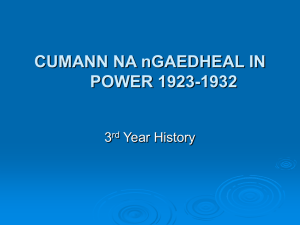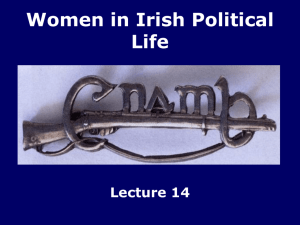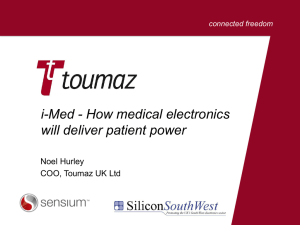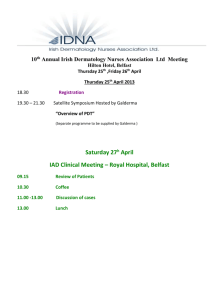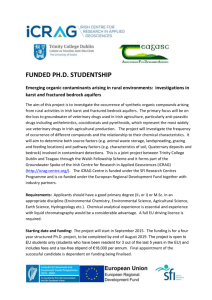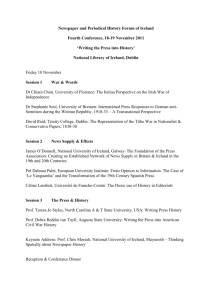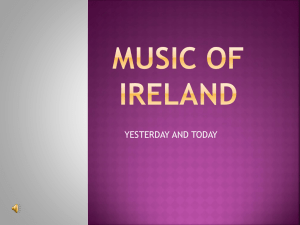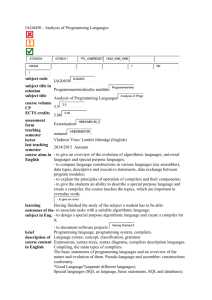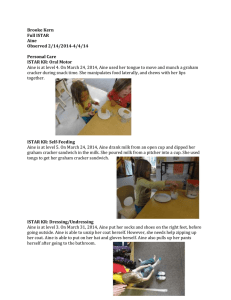Using The Military Archives in History
advertisement
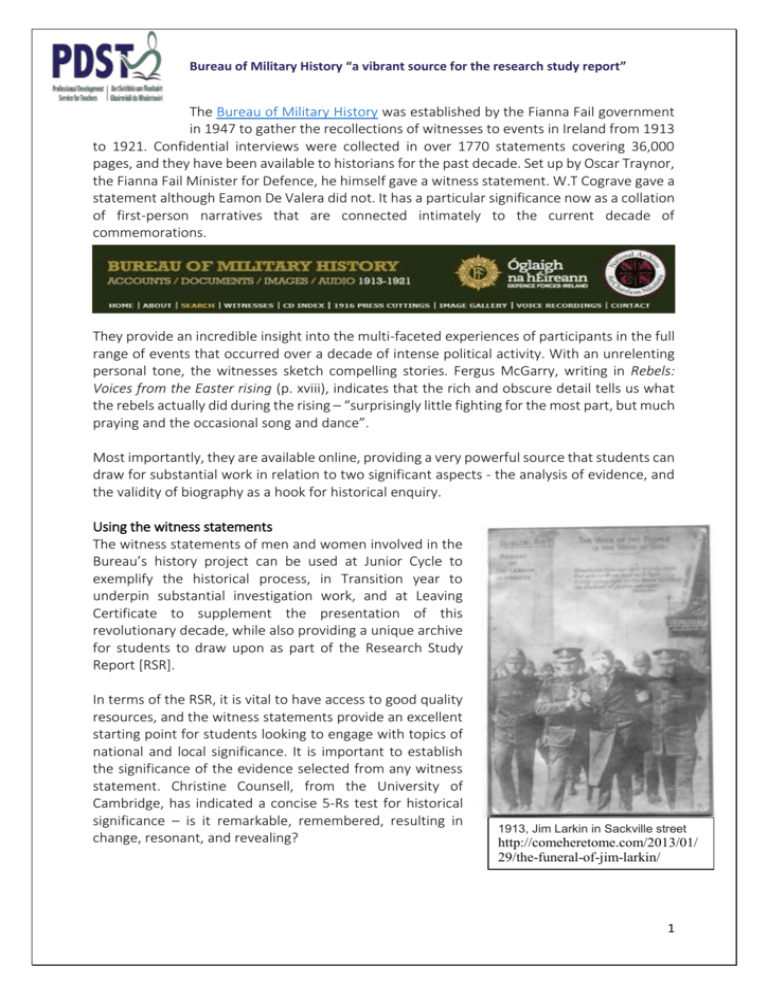
Bureau of Military History “a vibrant source for the research study report” The Bureau of Military History was established by the Fianna Fail government in 1947 to gather the recollections of witnesses to events in Ireland from 1913 to 1921. Confidential interviews were collected in over 1770 statements covering 36,000 pages, and they have been available to historians for the past decade. Set up by Oscar Traynor, the Fianna Fail Minister for Defence, he himself gave a witness statement. W.T Cograve gave a statement although Eamon De Valera did not. It has a particular significance now as a collation of first-person narratives that are connected intimately to the current decade of commemorations. They provide an incredible insight into the multi-faceted experiences of participants in the full range of events that occurred over a decade of intense political activity. With an unrelenting personal tone, the witnesses sketch compelling stories. Fergus McGarry, writing in Rebels: Voices from the Easter rising (p. xviii), indicates that the rich and obscure detail tells us what the rebels actually did during the rising – “surprisingly little fighting for the most part, but much praying and the occasional song and dance”. Most importantly, they are available online, providing a very powerful source that students can draw for substantial work in relation to two significant aspects - the analysis of evidence, and the validity of biography as a hook for historical enquiry. Using the witness statements The witness statements of men and women involved in the Bureau’s history project can be used at Junior Cycle to exemplify the historical process, in Transition year to underpin substantial investigation work, and at Leaving Certificate to supplement the presentation of this revolutionary decade, while also providing a unique archive for students to draw upon as part of the Research Study Report [RSR]. In terms of the RSR, it is vital to have access to good quality resources, and the witness statements provide an excellent starting point for students looking to engage with topics of national and local significance. It is important to establish the significance of the evidence selected from any witness statement. Christine Counsell, from the University of Cambridge, has indicated a concise 5-Rs test for historical significance – is it remarkable, remembered, resulting in change, resonant, and revealing? 1913, Jim Larkin in Sackville street http://comeheretome.com/2013/01/ 29/the-funeral-of-jim-larkin/ 1 Bureau of Military History “a vibrant source for the research study report” Aine Ryan, a Cumann na mBan member. As an instance of the female experience during the decade, I have selected Aine Ryan’s statement to highlight the intriguing narratives that emerge from the witness statements, and show how they might appeal to students. Aine Ryan, a Cumann na mBan member from Tullamore, Co Offaly, illuminates the major split in her town over participation in the world war. She provided basic medical assistance during the rising in Dublin, eventually ending up in the GPO. At one stage, she helped carry a zinc bath full of food across Sackville Street. She remembers reciting the rosary, remarking that she did not “know where all the Cumann na mBan met for the first religious objects that all the people in the GPO were time, today, at Wynn's Hotel on Abbey wearing came from”. After a speech from Pearse, she left Street in Dublin Photo: National Library of Ireland the GPO and the battle area under a flag of truce, remembering the abuse thrown at them by ladies in Summerhill. Released by the military after interrogation, she gives a vivid portrait of the difficulties over food supply. She returns to Tullamore, moves back to Dublin, collects for the dependants of prisoners, carries secret messages about British forces, and tries to help a friendly Black and tan after the conflict. She recalls the bitterness of the Treaty split in Cumann na mBan, and witnesses the first battles of the civil war in Dublin. Unlike many of her colleagues, she avoided arrest, and so held on her job. Other females that can be studied include Maud Gonne McBride, Kathleen Lynn (Irish Citizen Army), (Helena Molony (Irish Citizen Army), Min Ryan (Cumann na mBan, girlfriend of Sean MacDermott), Nancy Wyse Power (Cumann na mBan), Nora O'Brien (daughter of James Connolly), and Aine Ceant (widow of Eamon Ceannt). The Funeral of O’Donovan Rossa I want to illustrate also that events can also be presented in a personal and vivid manner through the statements, and this makes them especially valuable for ordinary level students. Sean T. O’Kelly recalled standing beside Patrick Pearse as he delivered his graveside oration: “I very well remember the profound impression Pearse’s speech on that day made ... He evidently had his speech, which was not too long, well memorised for he used no notes on the occasion … The I.R.B. and the Irish Volunteers were very proud of having been able to accomplish this military demonstration despite the orders of the British against the carrying of arms.” Aine Ryan came to Dublin for the funeral of O’Donovan Rossa in August 1915, and “watched it pass with my sister at the corner of Frederick Street. I think it was the first time I saw the Cumann na mBan uniform.” Another witness statement from Diarmuid O’Donneabhain, Co. Cork, describes how his band arrived to play at the funeral. However the crowds were so vast, they could not even get to Glasnevin: “When we arrived at Kingsbridge Station for the Rossa funeral, a Dublin officer 2 Bureau of Military History “a vibrant source for the research study report” escorted us, not down the quays, but to the right. It might be James’s Street. We were halted at a street crossing. We never reached Glasnevin on that day, as we were dismissed before we arrived at the Mater Hospital. We had refreshments and walked around until time came to mobilise for train to Cork.” Backing it up There is a wealth of high quality sources on the revolutionary decade that can be viewed in order to broaden the study away from the witness statements. I would encourage students to make use of four potential sources to provide the necessary context. The first is to draw on the indispensable search service provided by public libraries. The other three are hosted by Scoilnet.ie – the superb Dictionary of Irish Biography, The Irish Times digital archive, and the Ireland Collection, giving students access to a range of micro-studies on Irish history. Glasnevin Trust: http://www.glasnevintrust.ie/visit-glasnevin/news/the-fools-the-fools-the-fools/index.xml 3
